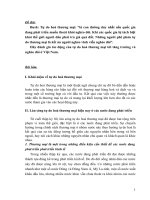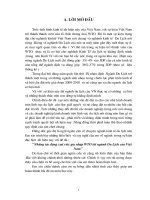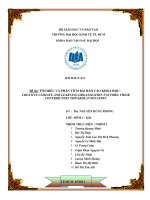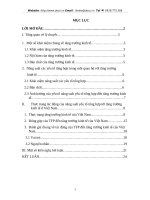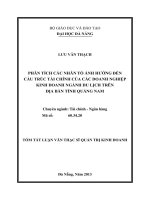Tác động của đại dịch covid 19 đến giá chứng khoán của các công ty trong nhóm ngành du lịch và giải trí ở Việt Nam
Bạn đang xem bản rút gọn của tài liệu. Xem và tải ngay bản đầy đủ của tài liệu tại đây (198.99 KB, 11 trang )
INTERNATIONAL CONFERENCE FOR YOUNG RESEARCHERS IN ECONOMICS & BUSINESS 2020
ICYREB 2020
STOCK RETURNS RESPONSES TO THE COVID-19 PANDEMIC:
THE CASE OF TRAVEL - LEISURE COMPANIES IN VIETNAM
TÁC ĐỘNG CỦA ĐẠI DỊCH COVID-19 ĐẾN GIÁ CHỨNG KHỐN
CỦA CÁC CƠNG TY TRONG NHĨM NGÀNH DU LỊCH
VÀ GIẢI TRÍ Ở VIỆT NAM
PhD,Le Hong Hanh; MA, Nguyen Thi Phuong Anh
University of Economics and Business, Vietnam National University Hanoi
Le Hanh Phuc
National Economics University, Hanoi
Abstract
This study investigates the impact of the Covid-19 pandemic on 20 listed companies in the
travel and leisure sector in Vietnam within the period from 23 January 2020 to 26 July 2020.
The selected period is considered from the day of the first case until the end of the first wave in
Vietnam. 14 breaking news that released officially by the government or ministry health of Viet-
nam is collected to measure the reaction of the stock market to those events by their abnormal
returns. Abnormal return is calculated by the gap of observed returns and expected returns using
the CAPM model. Cumulative abnormal return for the period of 5-10-15 days is also calculated
to report the market reaction. The results suggested that during selected events, most of the time
the market reacted negatively to the released news. In some cases, the stock price has reduced
statistically significant, however, surprisingly on the event of social distancing is reported, the
change of stock return is not significant. The only positive reaction is to the news that no new
community infection case on June 30, 2020.
Keywords: covid-19, event study, stock price, stock return, travel-leisure
Tóm tắt
Bài nghiên cứu đánh giá tác động của đại dịch Covid-19 đến các công ty niêm yết trong
lĩnh vực du lịch và giải trí ở Việt Nam trong giai đoạn từ ngày 23 tháng 1 năm 2020 đến ngày 26
tháng 7 năm 2020. Giai đoạn được xem xét tính từ khi bắt đầu ca nhiễm đầu tiên cho đến ngày
cuối cùng của đợt bùng dịch thứ nhất ở Việt Nam. Nhóm nghiên cứu đã lựa chọn 14 sự kiện (Tin
tức) được công bố chính thức bởi chính phủ hoặc bộ Y tế trong giai đoạn nghiên cứu để tính tốn
lợi nhuận bất thường của các doanh nghiệp trong lĩnh vực này Lợi nhuận bất thường được tính
bằng sự chênh lệch giữa lợi nhuận kỳ vọng dựa trên mơ hình CAPM và lợi nhuận thực tế. Sau
đó, lợi nhuận bất thường tiếp tục được phân tích theo lợi nhuận cộng dồn để đánh giá tác động
của tin tức sau 5-10-15 ngày tính từ ngày công bố. Kết quả nghiên cứu cho thấy, đại dịch Covid-
19 đã có tác động tieu cực đến lợi nhuận của cổ phiếu trong lĩnh vực du lịch trong suốt giai đoạn
1262
INTERNATIONAL CONFERENCE FOR YOUNG RESEARCHERS IN ECONOMICS & BUSINESS 2020
ICYREB 2020
này. Tuy nhiên, vào ngày 30 tháng 6 năm 2020, khi có sự kiện khơng có ca nhiễm mới trong cộng
đồng đã giúp giá chứng khốn của nhóm ngành này tăng trở lại.
Từ khóa: covid-19, nghiên cứu sự kiện, giá cổ phiếu, lợi tức cổ phiếu, du lịch-giải trí
1. Introduction
The Covid-19 pandemic is becoming one of the most extreme crisis that human beings
faced since the World War II which not only translated to the health concern but also adversely
to the global economy (Fernandes, 2020; McKibbin, 2020; Nicola, 2020; Ozili, 2020). Vietnam,
a neighbor country with high volume of trade with China, was expected as a high-risk country to
the pandemic . Nevertheless, almost a year since the outbreak of the Covid-19, in comparison to
other affected countries, Vietnam has shown a considerably more optimistic situation with strict
control of the death cases and humane motto “No one is left behind” to the Vietnamese citizens
from all over the world. Moreover, while it is predicted that most countries are likely to be plunged
into recession, with per capita income contracting in the largest fraction of countries globally
since 1870, Vietnam is a scarce sample witnessing the increase of GDP even in the peak time of
the pandemic, with the growth rate of 0.4% in the second quarter of 2020 . Likewise, in May
2020, Vietnam was Asia’s best stock market performer with the stock benchmark index growth
of 13 per cent. There is no doubt that Vietnam is a remarkable factor in the period of the
pandemic with timely managing policies despite being under-resourced and Vietnam’s stock
market is proving its resilience during the pandemic.
On the other hand, as a whole, Vietnam’s economy has been suffering with the lowest
growth rate within 35 years . The government has offered a number of monetary and fiscal policies
to support domestic economic sectors but the recovery of the economy especially of the travel
and leisure sector has been fragile . As a touristy destination, Vietnam is considered as one of the
fastest growing tourism country in the world (Chien, 2012; UNWTO, 2020) with about 2,000
national historic sites and 125 beaches and parks, thus the country has created high demand from
both domestic and international visitors. In 1990, while the total revenue from travel and leisure
sector humbly stood at 1.340 billion VND, the figure has leaped to 755.000 billion VND in 2019
. After 30 years of global integration, the number of domestic and international travelers to tourist
attractions in Vietnam witnessed an astonishing increase of 85 times and 72 times respectively ,
along with a large number of beach-based resorts have been awarded globally reputed prizes . In
regards to macro economy, travel and leisure has become a new major economic resource of
Vietnam . According to a survey from a well-known travel agency named TripAdvisor in 2018,
Vietnam was voted as one of the 10 best places to visit in the world .
Nevertheless, in recent times, due to adverse impacts of the Covid-19 pandemic, the State
of Vietnam has to close the borders which totally cut off the international market of the travel
and leisure sector. Within the first quarter, the revenue from travel and leisure was estimated at
126.2 billion VND which experienced a 9.6% decrease compared with the same period of last
year . The State has issued a number of supportive policies to encourage domestic travelers, hence
after the first waves of the outbreak, travel and leisure has experienced a steady recovery.
1263
INTERNATIONAL CONFERENCE FOR YOUNG RESEARCHERS IN ECONOMICS & BUSINESS 2020
ICYREB 2020
However, when the second waves of the pandemic occurred in Da Nang, this sector was knocked
down another time. It now becomes more challenging for the travel and leisure sector in Vietnam
to make a full recovery from the Covid-19.
This study analyzes the changes in the stock price of listed companies in Vietnam after occurring the Covid-19 by using the event study approach. There are five main parts in this paper,
including the introduction, literature review, research methodology, results, and conclusion. In
particular, this research offers a glimpse into the adverse impact of Covid-19 on the stock market
of the travel leisure industry by considering not only other nations cases but also previous similar
historical crises. Using the CAPM model, the study has pointed out the negative correlation of
the Covid-19 pandemic to the stock market of the tourism sector.
2. Literature reviews
Travel and leisure, so-called the smokeless industry, is one of the most crucial businesses
in the world and has become a major income of many nations . According to the World Travel
Tourism Council, the global revenue of the travel and leisure industry was approximately 2.9
trillion dollars in 2019, accounted for nearly one-third of the global GDP. Much as a profitable
sector over the last decade, this sector is indeed vulnerable to externalities . The 2020 novel
coronavirus has been creating an unprecedented disruption for the global travel and leisure due
to restricted mobility and social distancing . For at least 40 years, numerous epidemics and
pandemics have occurred unexpectedly around the world but none of them made all of the
countries simultaneous closed their borders and banned arrival from foreigners like the Great
Lockdown in 2020 . The impacts of the pandemic on the global travel and leisure sector within
the first six months of 2020 was already three times that of the 2009 Global Economic Crisis
with a 56% drop in tourist arrivals, 300 million tourists fall and $320 billion USD lost in
international tourism receipts. Another report from the United Nations World Tourism
Organization had estimated a potential loss of worldwide travel and leisure sector due to the
Covid-19 is from USD30-50 billion, and 100.8 million jobs worldwide in 2020. Furthermore, as
the number of infections and deaths of the Coronavirus has been accelerating around the world,
people have to comply with social distancing by staying and working at home via various online
platforms. Online shopping also becomes more prevalent in the circumstances of a global
pandemic, which results in fewer international shopping trips . Well-known tourism destinations
such as Italy, Greece, or Germany witnessed the hardest hit consequences of the Covid-19
pandemic with the percentage changes year-on-year in 2020 are all above minor 80 percentage .
A number of studies have been conducted on how different types of crises affected to travel and
leisure sector, and its affiliated sectors but none of the current crisis in the last decade such as the
September 11 terrorist attacks , the global economic crisis in 2008 , the MERS-CoV epidemic ,
or the Ebola epidemic led to such long-term decline in the global development of travel and
leisure like this 2020 pandemic . It is suggested that that the travel and leisure sector is resilient
to external shocks and this sector so far has been susceptible with various crises, including natural
disasters, political conflicts, terrorism, or weather (Okumus, 2005; UNWTO, 2020).
In regards to the stock market, a number of studies have illustrated the adverse effects of
1264
INTERNATIONAL CONFERENCE FOR YOUNG RESEARCHERS IN ECONOMICS & BUSINESS 2020
ICYREB 2020
historical epidemics to the stock market (Gerding, 2005; Lim, 2008) but none of the previous
epidemics, including the great Spanish flu, has affected the stock market as seriously as the Covid19 pandemic . According to a study of , in comparison between flu epidemic and war deaths in
the typical countries, the impacts on stock returns in the period of epidemics were severer than
that in the war, with the figure of stock return was negatively by 26 percentage and 19 percentage,
respectively. It is obvious that the stock market has a link to the severity of the epidemic outbreak
in each country due to it is catalyzed by economic losses. In the past, when epidemics happened,
there was, in fact, only the stock market in the U.S suffered whereas in the 2020 pandemic,
together with the U.S, stock markets in Europe and Asia have also plunged . The 2020 pandemic
has recorded the darkest days of many stock index with the FTSE, the UK’s main index, dropped
more than 10% in March 2020, in its worst day since 1987; the stock market in Japan plunged
more than 20% from its highest position in December 2019 . The frequency of large daily stock
market moves during this period is considered an exception . Besides the risk to human health,
the volatility of the stock market has surged to be a prominent concern.
So far, during the period of the Covid-19 pandemic, the existing literatures are limited
to the impacts of the pandemic to the tourism industry, or to the stock market of each particular
country but have not directly linked to the stock returns of companies in the travel and leisure
sector yet. In addition, the effect scale of the pandemic to each country is significantly different.
Given the gap in literature, in this paper, we are going to empirically investigate the effects of
the Covid-19 to the more specific sector in the tourism industry called the travel and leisure
sector.
3. Methodology and data
3.1. Return analysis
The methodology is used to calculate the stock returns of observed listed companies in the
travel and leisure sector in Vietnam. The abnormal return of the portfolio is calculated by the average of each securities listed on both Hanoi and Hochiminh stock exchange. Abnormal return is
the difference between observed and predicted returns. Observed return is the return calculated
based on history trading data (formula 1):
Observed return = ln (P1/P0) (1)
Predicted or expected return is constructed based on CAPM model:
E(Rcst ) = βcst0 + βcst1 (rmkt-rft ) + εcst (2)
where: rmkt is the return on the market index and rft is the risk-free rate. βcst0 and βcst1
are respectively the intercept and the slope of the CAPM and εcst is the error term.
Abnormal return= Predicted return- Observe return
After that, we analyzed the returns by combining them with Event study methods. Selected
events are considered in this study. Those events are the official announcement of the government
or the Ministry of Health. We have some hypothesizes:
H1: Negative news have negative impacts on stock returns
1265
INTERNATIONAL CONFERENCE FOR YOUNG RESEARCHERS IN ECONOMICS & BUSINESS 2020
ICYREB 2020
H2: Positive news have positive impacts on stock returns.
According to the efficient market hypothesis (EMH), the market reacted instantly to any
available information. In the absence of market efficiency, market participants may over-react or
under-react to an event or announcement. To investigate this possibility, the cumulative abnormal
return (CAR) is estimated over n trading days by using the equation
The t statistic of estimated CAR is calculated as
(6)
(7)
By examining the significance of CARs, we find out whether or not the market exhibits
mean reversion.
3.2. Research process:
In this study, the target is to calculate the abnormal returns of the travel and leisure
listed companies by comparing the observed and expected returns. The observed returns are
collected from historical data, meanwhile, the expected return is calculated by using CAPM
model. (Figure 1)
Figure 1: Research process
3.3. Data
The study uses the daily closing stock price of listed companies in the HNX and HOSE
Stock exchange. The list contains 20 travel leisure companies from the 23/01/2020 to 26/07/2020
to measure the effect of COVID-19 on this industry.
To analyze the correspondence between the stock market trends with the following events,
we have collected news from reliable sources, which are from the government and the Ministry
of Health. In detail, on January 31, Vietnam confirmed the first two cases of Coronavirus in Ho
Chi Minh City. After eight days, the Prime Minister announced the outbreak and tighten222ed
the borders. Within continuous 22 days, Vietnam recorded no community infection case until
March 6, the seventeenth case was outbreak. The Prime Minister immediately directed a national1266
INTERNATIONAL CONFERENCE FOR YOUNG RESEARCHERS IN ECONOMICS & BUSINESS 2020
ICYREB 2020
scale social distancing from April 1. Accordingly, until June 30, Vietnam recorded no community
infection case within 74 days recovery full.
Date
Table 1: Spotlighted events during the pandemic period in Vietnam
23/01/2020
30/01/2020
01/02/2020
13/02/2020
25/02/2020
06/03/2020
10/03/2020
11/03/2020
18/03/2020
22/03/2020
31/03/2020
18/04/2020
30/06/2020
26/07/2020
Events
Vietnam confirmed the first two novel coronavirus cases at Sai Gon’s Cho Ray
Hospital.
According to the Ministry of Health, three Vietnamese citizens returning from
China’s Wuhan tested positive for coronavirus.
A 25-year-old woman (6th case) had the coronavirus infection in Khanh Hoa
province. She directly contacted with two Chinese father and son (1st and 2nd
case). Notably, this is the first case of domestic transmission in Vietnam, so
Prime Minister Nguyen Xuan Phuc announced the outbreak in Vietnam and
decided to tighten the border.
Vietnam isolated nearly 11,000 people to control coronavirus outbreak in Son
Loi Commune in Binh Xuyen District.
The 16th case left the hospital after being tested negative from the Covid-19.
Vietnam was temporarily free from the Covid-19 outbreak at that time.
Hanoi urgently announced the 17th case, a 26-year-old woman, after 22 days
without any new coronavirus case in Vietnam.
The 34th patient, a 51-year-old female, flew from Washington (USA) to Tan
Son Nhat International Airport. She has transmitted coronavirus to 11 people,
including five relatives, three direct contacts, and three indirect contacts.
WHO officially announced that Coronavirus (Covidovid-19) is a global pandemic.
Vietnam temporarily halts visa issuance for foreigners entering the country for
30 days and restrict international flights.
Vietnam exceeds 100 patients and has 19 new cases in one day. This increase
is recorded as the highest one since the first day of the pandemic.
Prime Minister directed a national-scale social distancing from 0:00 April 1.
No new Covid-19 case was reported in Vietnam.
Vietnam had no local transmission case in 74 days
The source of the 418th patient in Da Nang cannot be identified. The social
distance measures have been restarted.
1267
INTERNATIONAL CONFERENCE FOR YOUNG RESEARCHERS IN ECONOMICS & BUSINESS 2020
ICYREB 2020
4. Kết quả
4.1. Descriptive statistics
Table 2: Average observed return of listed companies
Company’s name
Average observed return
Royal intl.corporation
0.067%
Saigon hotel
-0.093%
Vietnam sun
0.211%
Tay ninh cable car tour
-0.164%
Thanh thanh cong tourist
-0.042%
Lang son tourism
0.091%
Phuong dong petr
0.070%
Thuan thao
0.384%
Vung tau intourco resort
0.015%
Dan sem water park
-0.110%
Daklak tourist
-0.064%
Hoi an tourist holding
-0.178%
Phu nhuan trading
0.061%
Ben thanh service
-0.111%
Saigon tourist transport
-0.114%
Atesco industrial cartering
-0.129%
Vietnam airlines
-0.009%
Tay ninh tourist
-0.186%
Vietjet aviation
-0.185%
Ha noi tourist service
-0.688%
Table 2 illustrates the average returns on stock price of 20 listed companies in the travel
and leisure sector in Vietnam from January 1, 2020 to July 26, 2020. Overall, the average returns
of observed companies were majorly negative, and the mean was negative 0.0587%. It can be
noticed that 45 percent of observed companies witnessed the recession in average stock returns
above negative 0.1 percent, with the worst average return from Hanoi tourist service at negative
0.688 percent. This outcome is obviously caused by the sharp decrease of travel and leisure’s
market during the Covid-19 pandemic time. Meanwhile, in the sense of positive growth, Thuan
Thao and Vietnam Sun experienced the most prominent returns at 0.384 percent and 0.211 percent
respectively. Most of the positive average returns of the other companies stood under 1 percent.
This result suggests that companies, which offer multiservice in the travel and leisure sector, are
likely to perform better than mono-service travel and leisure companies.
1268
INTERNATIONAL CONFERENCE FOR YOUNG RESEARCHERS IN ECONOMICS & BUSINESS 2020
ICYREB 2020
4.2. Abnormal return
DATE
1/23/2020
AR
0.00
1/30/2020
(0.02)***
2/13/2020
(0.01)
2/3/2020
2/25/2020
3/6/2020
3/10/2020
2/11/2020
3/18/2020
2/23/2020
3/31/2020
4/20/2020
6/30/2020
(0.01)
(0.00)
Table 3: Abnormal return
CAR5
CAR10
(0.02)
(0.04)**
0.01
0.00
(0.02)
(0.02)
(0.01)
(0.01)
(0.05)***
(0.03)
(0.05)*
0.01
(0.04)
0.01
(0.07)***
0.00
0.01
(0.01)
(0.02)
(0.00)
0.03
0.04
(0.01)
(0.02)
0.02**
0.04**
(0.01)
(0.01)
(0.04)
(0.08)***
(0.01)
(0.00)
(0.06)**
(0.03)
(0.06)***
(0.00)
(0.04)
(0.01)
(0.00)
(0.01)
CAR15
(0.02)
(0.02)
0.05 **
(0.03)
0.00
0.03
0.03
Note: AR: abnormal return. CAR5/10/15 : Cumulative abnormal return after 5/10/15 days of event
Table 3 presents the abnormal return and cumulative abnormal return for the portfolio of
travel leisure listed companies based on the analyzed events. In most of the case, the spotlighted
events during the Covid-19 period have caused negative abnormal return on both the day of the
event and the following days.
On January 23, Vietnam recorded the first case of infection in Vietnam, the effect of this
event on the stock returns in the travel and leisure sector is relatively mild. Nevertheless, after 5
to 10 days, the cumulative abnormal return of observed companies had witnessed the downward
trend and after 15 days, the cumulative abnormal return was decreased to the significant statistical
meaning.
The entire following events had caused a decline in stock returns of those companies.
Notably, on March 6 and March 10, when the first community infection case in Hanoi and HCMC,
the stock returns had been significantly impacted and the level of statistical significance is
considerably high.
On April 4, Vietnam recorded no new infection cases. This event had positively influenced
the stock returns in the travel and leisure sector in Vietnam. In particular, the stock returns had
1269
INTERNATIONAL CONFERENCE FOR YOUNG RESEARCHERS IN ECONOMICS & BUSINESS 2020
ICYREB 2020
leaped to 2 percent, 4 percent, 5 percent, and 3 percent respectively on the event day and the
following 5 days, 10 days, and 15 days.
Exceptionally, when the government announced the social distancing policy, the stock
returned remained unchanged on that day. In the next 5 following days, the abnormal returns
witnessed the value of 0. One possible reason for this phenomenon is the pre-awareness of people
about the social distancing policy, hence, the reactions of both investors and stock returned to
the new policy had no significance.
All in all, most of the negative breaking news related to the Covid-19 pandemic has
negative impacts on the travel and leisure sector in Vietnam. For selected positive news, only the
news released in April 2020 about zero new infection cases had positive outcomes on the stock
returns of observed companies in the travel and leisure sector.
5. Conclusion
The negative influence of Covid-19 on the stock market and the travel leisure industry has
provoked the instability of this sector. With every negative information, such as case
announcements and social distancing decisions provided by the government and the health
ministry, the stock price experienced a downfall. However, once there is a decrease in the number
of cases, the stock price is inclined to rise again. This negative relationship has demonstrated the
cautiousness of investors the toward travel leisure industry. It is reasonable because the Covid19 is a contagious infection; therefore, reducing various types of activities, especially ones in the
travel leisure sector, is the optimum option.
Under the circumstance of the complicated pandemic, our studies have offered some
recommendations:
iRegarding tourism companies:
- In order to limit potential risks, they need to take different measures to maintain operations
until the end of the epidemic.
- While the pandemic has not been controlled yet, if investors have no excess idle capital,
they should not invest on this sector. However, if the amount of idle capital is large enough,
investors can consider the investment. Once the pandemic is over, the tourism industry will be
recovered, and thus investors can take advantages from the increase in prices.
- Companies should continue to promote their image by innovative advertisements and
proper discount policies so that they can attract domestic markets.
- Companies that depend majorly on international market should adjust the policies to serve
both domestic and international market.
- If the number of customers remains limited, companies may upgrade their facilities, or
training staff to improve service quality so that when the pandemic is over, customers may enjoy
a better service.
iRegarding the State:
- The State should have tax reduction policies for tourism and travel companies so that
these companies may not under great pressure of profit and expenses.
1270
INTERNATIONAL CONFERENCE FOR YOUNG RESEARCHERS IN ECONOMICS & BUSINESS 2020
ICYREB 2020
- The State should join hand to promote and develop tourism sector to attract domestic
tourists, especially tourists from regions not affected by epidemics.
REFERENCE
Anh, L. K. (2020). Ảnh hưởng của dịch Covid-19 tới ngành Du lịch Việt Nam. Tap
Chi Cong Thuong.
Baker, S. R. (2020). The unprecedented stock market reaction to COVID-19. The
Review of Asset Pricing Studies.
Barro, R. U. (2020). Coronavirus Meets the Great Influenza Pandemic. VoxEU.
org, 20.
Blake, A. &. (2003). TOURISM CRISIS MANAGEMENT US: Response to
September 11. Annals of Tourism Research, 813-832.
Bloomberg. (2020). Vietnam is Asia's best stock market performer in May.
Chakraborty, I. &. (2020). COVID-19 outbreak: Migration, effects on society, global
environment and prevention. Science of the Total Environment, 138882.
Chien, G. C. (2012). Combination of theory of planned behavior and motivation:
An exploratory study of potential beach-based resorts in Vietnam. Asia Pacific Journal
of Tourism Research, 17(5), 489-508.
Cró, S. &. (2017). Structural breaks in international tourism demand: Are they
caused by crises or disasters? . Tourism Management, 3-9.
Fernandes, N. (2020). Economic effects of coronavirus outbreak (COVID-19)
on the world economy. SSRN 3557504.
George-Parkin, H. (2020). Is click-and-collect the future of shopping? BBC.
Gerding, E. F. (2005). The next epidemic: Bubbles and the growth and decay
of securities regulation. Conn. L. Rev., 38, 393.
Gopinath, G. (2020). The Great Lockdown: Worst Economic Downturn Since the
Great Depression. IMF Blog.
Gössling, S. S. (2020). Pandemics, tourism and global change: a rapid assessment
of COVID-19. Journal of Sustainable Tourism, 1-20.
GSO, G. S. (2020).
Khuong, M. N. (2014). The Influences of Push and Pull Factors on the International
Leisure Tourists' Return Intention to Ho Chi Minh City, Vietnam--A Mediation Analysis
of Destination Satisfaction. International Journal of Trade, Economics and Finance,
5(6), 490.
Kumar, S. (2005). Resource use and waste management in Vietnam hotel industry
. Journal of cleaner production, 13(2), 109-116.
1271
INTERNATIONAL CONFERENCE FOR YOUNG RESEARCHERS IN ECONOMICS & BUSINESS 2020
ICYREB 2020
La, V. P. (2020). Policy response, social media and science journalism for the
sustainability of the public health system amid the COVID-19 outbreak: The vietnam
lesson. Sustainability.
Lim, K. P. (2008). Financial crisis and stock market efficiency: Empirical evidence
from Asian countries. International Review of Financial Analysis, 17(3), 571-591.
McKibbin, W. J. (2020). The global macroeconomic impacts of COVID-19: Seven
scenarios.
Nicola, M. A.-J. (2020). The socio-economic implications of the coronavirus
pandemic (COVID-19): A review. International journal of surgery (London, England),
78, 185.
Okumus, F. A. (2005). The impact of Turkey’s economic crisis of February 2001
on the tourism industry in Northern Cyprus. Tourism Management, 95-104.
Okumus, F. A. (2005). The impact of Turkey's economic crisis of February 2001
on the tourism industry in Northern Cyprus. Tourism Management, 26(1), 95-104.
Ozili, P. K. (2020). Spillover of COVID-19: impact on the Global Economy.
Available at SSRN 3562570.
Petrus, M., & Unathi, H. (2019). The Tourism Impact of Ebola in Africa: Lessons
on Crisis Management. African Journal of Hospitality, Tourism and Leisure.
Phillips, M. (2020). This Market Is Nuts’: S&P 500 Hits Record, Defying Economic
Devastation. NYTimes.
TTDL, T. t. (2020). Hoạt động lữ hành ngày càng sôi động với sự lớn mạnh của hệ
thống doanh nghiệp.
UNWTO. (2020). NTERNATIONAL TOURIST NUMBERS DOWN 65% IN
FIRST HALF OF 2020.
Vong. (2018). Vietnam among world’s top destinations: TripAdvisor. Vietnam News.
Wen, J. K. (2020). COVID-19: potential effects on Chinese citizens’ lifestyle and
travel. Tourism Review.
Wong., A. S. (2004). Economic Impact of SARS: The Case of Hong Kong. Asian
Economic Papers, 62-83.
Wordbank. (2020). The Global Economic Outlook During the COVID-19
Pandemic: A Changed World.
Zhang, D. H. (2020). Financial markets under the global pandemic of COVID-19.
Finance Research Letters, 101528.
1272
